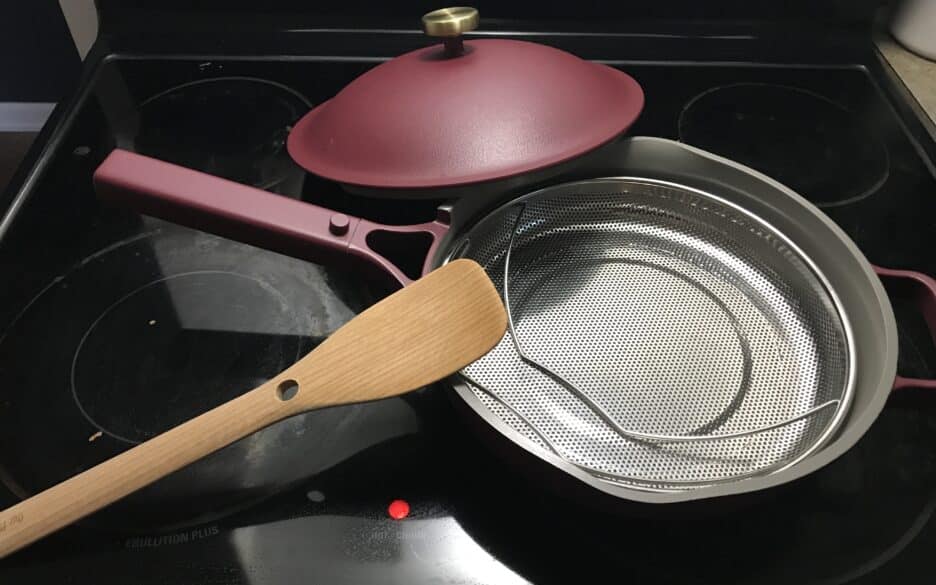Beloved on instagram, the Always Pan 2.0 promises to replace at least 10 kitchen products. Does this non-toxic, non-stick pan live up to the hype? Here’s our honest review based on cooking with the Always Pan 2.0 at home.
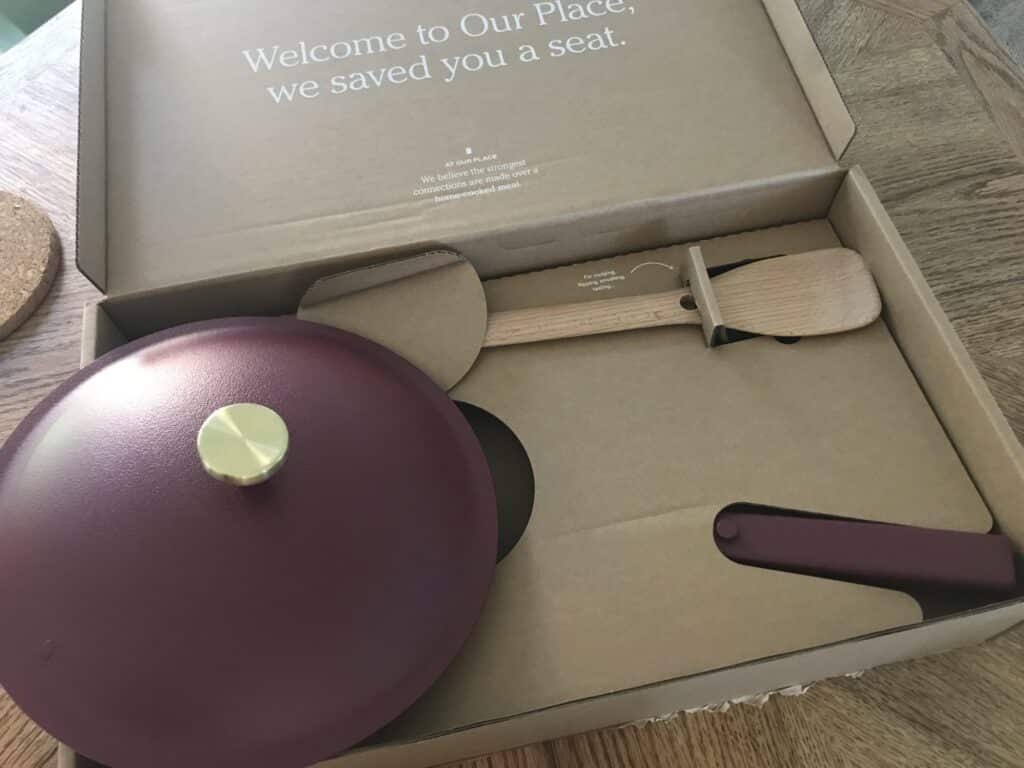
I’ve had my eye on an Always Pan 2.0 from Our Place for a while, so the timely reader question below was the spur needed to test one out.
Hi there,
I am looking into purchasing new pots and pans and wondered if you guys had any insight into the Our Place ceramic set?
I appreciate learning about Green Pan’s lawsuits – something felt a bit off about that company!
Look forward to hearing from you.
Many thanks,
Jess
Thanks for the question, Jess.
If you’ve not yet bought an Always Pan 2.0, my advice is to consider the purchase very carefully.
This pan has a lot going for it, but there are some serious issues that Our Place would be wise to address. Sure, the 2.0 version is an improvement on the original but the 3.0 (if there is one) needs to up its game even further in order to make our list of non-toxic nonstick pans.
I got my Always Pan 2.0 in Charm, which was one of six limited colors that extend the core collection of six color options. Charm seems to have been replaced by Rosa, which is the same color but doesn’t have the gold lid handle like mine.
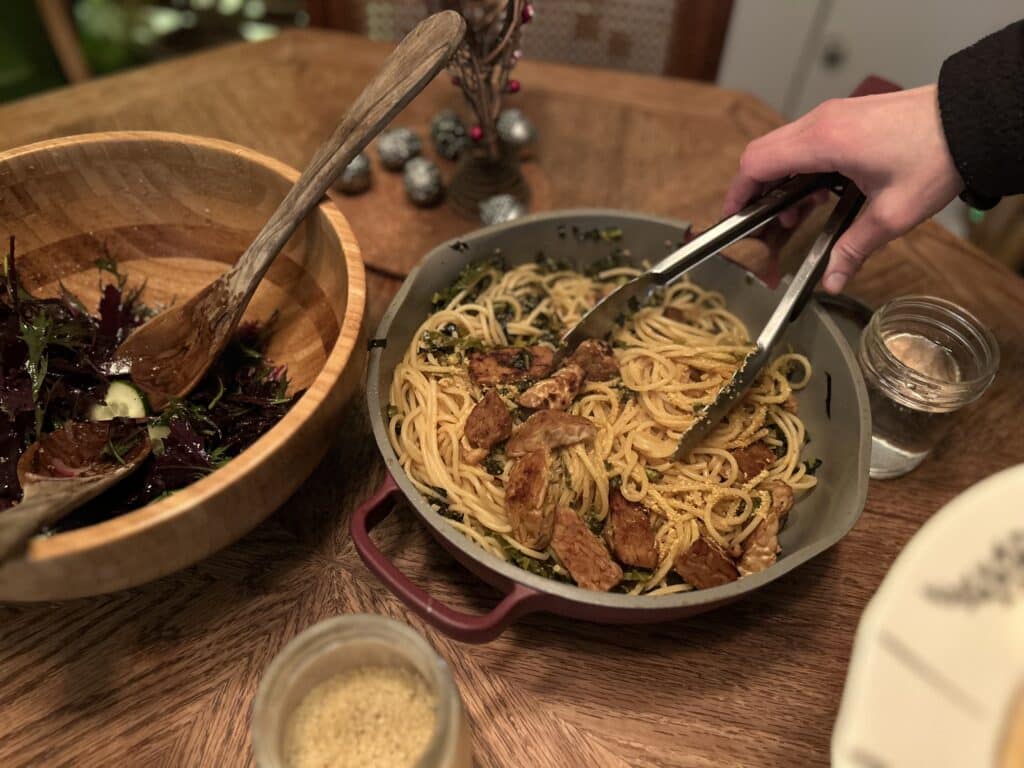
So far, we’ve made pancakes, steamed dumplings and veggies, reheated leftover spaghetti bolognese, cooked and drained noodles, and done much much more with this pan. My wife has deliberately used it for everything she can think of and she adores it. I love it too, but I’m wary of the non-stick wearing off or otherwise incurring damage soon.
Here’s a comprehensive look at the Always Pan 2.0, based on my experiences as a well-versed home cook with an (opinionated) wife who also loves to cook.
- Looks amazing… at first
- Very non-stick and slippery… at first
- Lightweight – much lighter than cast iron or pure ceramic
- Requires only low to medium heat (saves energy)
- Meant for small kitchens with little storage space
- Enough volume to cook big meals to share
- Some lovely and smart design features
- Great choice of colors
- Works with all stovetops (though some issues with induction)
- Smart, sustainable packaging great for gifting
- No third-party test results available for toxicity
- Non-stick surface seems to get sticky after six months on average
- Helper handle gets dangerously hot
- Long handle is bulky, boxy, and uncomfortable to hold
- Hard to clean after six months or one sticky spillover
- Steamer basket sits very low in pan, risking boiling or boiling dry
- Fussy care and use rules to avoid damage
- Staining and discoloration compromises aesthetic after six months or less
At a glance:
- Price: $120-$180
- Materials: Non-stick ceramic coating, recycled aluminum, stainless steel handle and base, plus beechwood spatula
- Compatible with: All stovetops including induction
- Oven safe: Yes to 230 C (440 F)
- Dishwasher safe: Yes, technically, but not recommended (handwash only to preserve coating)
- Made in: China, most likely (possibly in Mexico, Thailand, or India)
- Ships: Free and in sustainable packaging
- Trial and returns: 100 days and free returns
Brand
Our Place is a newer cookware brand founded by a woman of color and based out of LA. The company sells cookware and dinnerware and has a mission to bring people together over good food cooked at home, which is admirable.
Our Place intends to make thoughtful products that help beginner cooks and those with more experience in the kitchen. The aesthetic is unique and attractive, with a lot of social media attention. When Our Place launched the original Always Pan in 2019, instagram influencers helped make this the must-have pan for millennials.
Four years later, Our Place offers the new and somewhat improved Always Pan 2.0. We compare the two below.
Our Place says it uses ethical factories and a sustainable supply chain but offers nothing to back this up. At the time of writing, Our Place says on its website that its products are designed in LA and made in:
- America
- Thailand
- China
- India
- Morocco
- Mexico
- and elsewhere.
This, by itself, means the products may have a significant carbon footprint before they reach your home.
The company also claims its products are made with recycled post-consumer aluminum and non-toxic materials but, again, offers no GRS certification for the recycled components nor any third-party test results. And, let’s be clear, most aluminum (around 75%) is recycled, with most of the aluminum ever produced still circulating today, so this isn’t really a distinguishing feature of this pan.
Sustainable packaging
Our Place does package its products in sustainable materials, though. Here’s how my Always Pan 2.0 arrived, with no single use plastics, just recyclable cardboard.
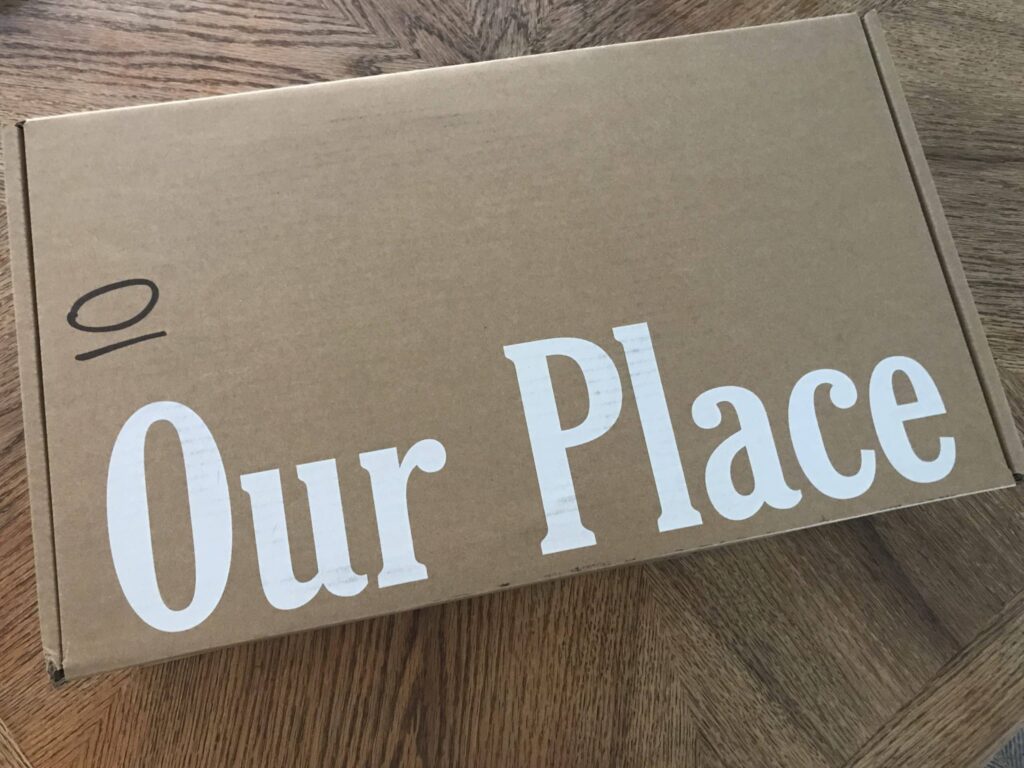
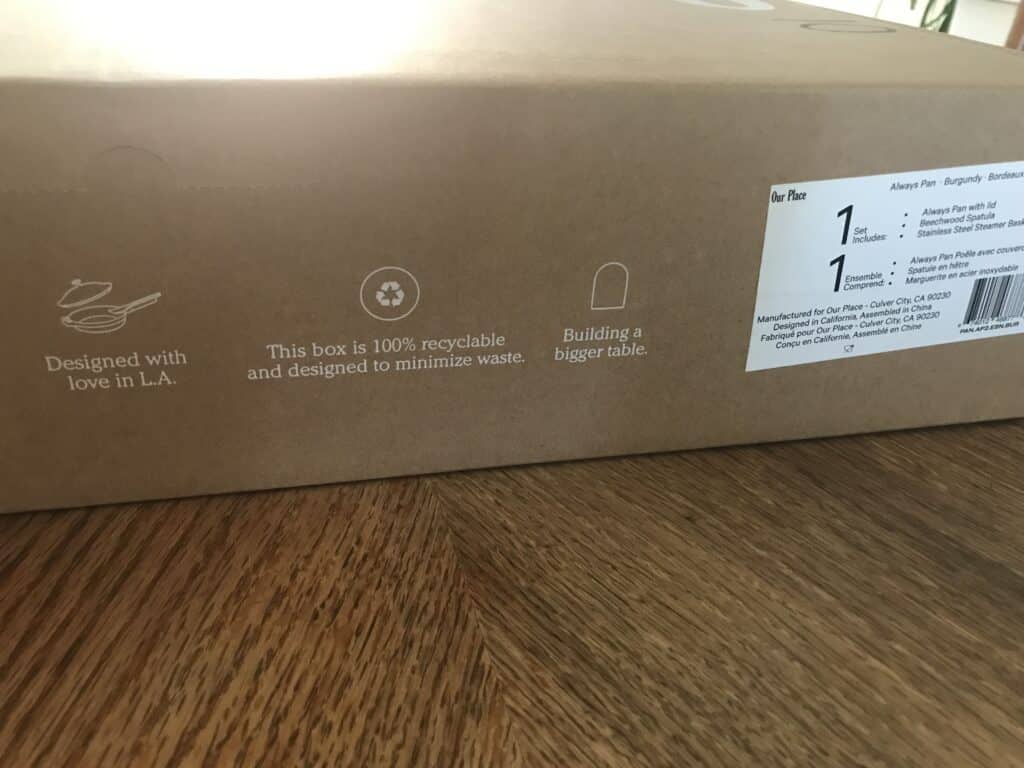
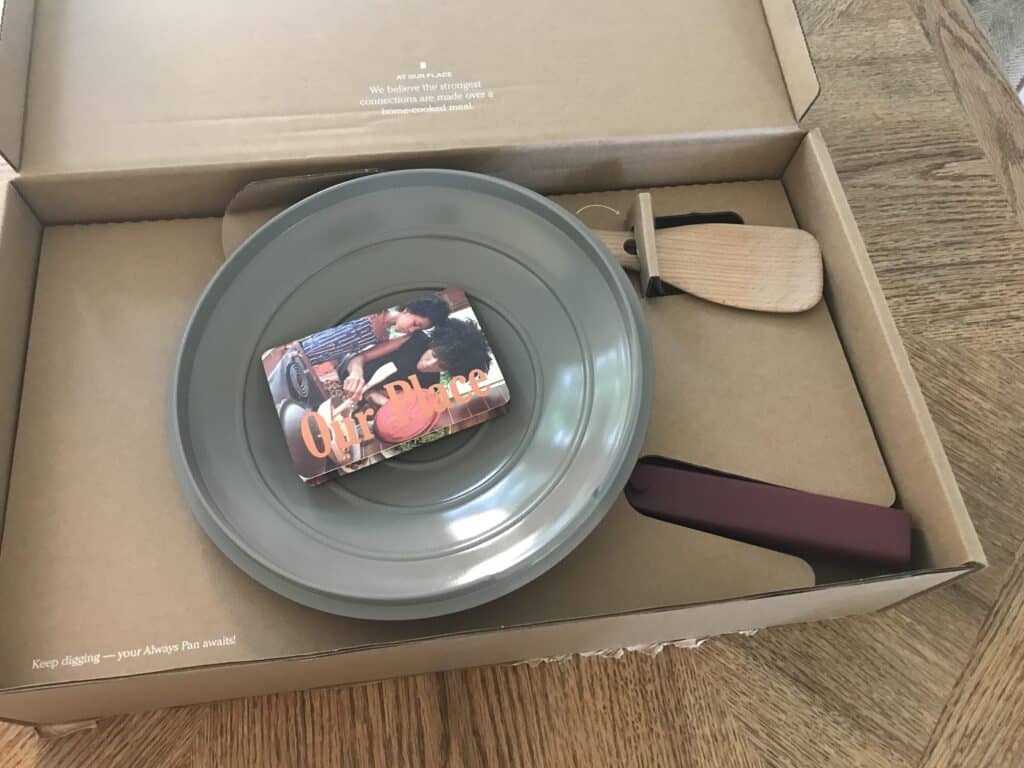

Non-toxic?
My honest answer is that I don’t know. I appreciate that Our Place uses a ceramic coating instead of PTFE but I don’t appreciate the lack of transparency around testing or composition.
Made with 100% post-consumer recycled aluminum and without potentially harmful toxins.
Our Place website
Our Place doesn’t publish results of any third-party testing, despite saying a couple of years ago that it would. I contacted Our Place to ask for copies of test results. I made sure to specify that, as a journalist, I was happy to use this information without revealing anything proprietary. I just want to see the reports they say back up the claims about non-toxicity.
The response I got via email:
“We take health and safety very seriously at Our Place and hold ourselves to the highest standard. As we state on our website, our coatings are specifically made without PFAS, PFOAS, lead, and other heavy metals, and we back that claim up with rigorous third-party testing.
We do not release our testing reporting as they do contain proprietary information. If we can answer any questions about our products, though, please let me know.”
Our place CSR via email
I tried a second time, again noting I was happy to treat proprietary information with sensitivity. No dice. I still haven’t seen any test results or third-party certification to demonstrate that Our Place is genuinely non-toxic.
On the company’s FAQ page, there’s a bit more information, but it’s still not clear what’s in the coating:
Our ceramic nonstick coating is made without potentially toxic materials including PTFE, PFOA, and other PFAS (which are used in the majority of nonstick cookware). PFAS are nicknamed “Forever Chemicals,” because they do not break down easily in the environment or in the human body. As a result, they bioaccumulate over time, making them a highly concerning chemical group. PFAS-based coatings can also release toxic fumes when overheated.
Our Place FAQs
Brands like Caraway, Alva, and Xtrema all have been very forthcoming about the results of third party testing, so Our Place’s unwillingness to share this data puts them behind the competition. It also means they maintain a low ranking on our list of non-toxic cookware brands.
Despite my misgivings, there’s still a lot to love about the Always Pan 2.0.
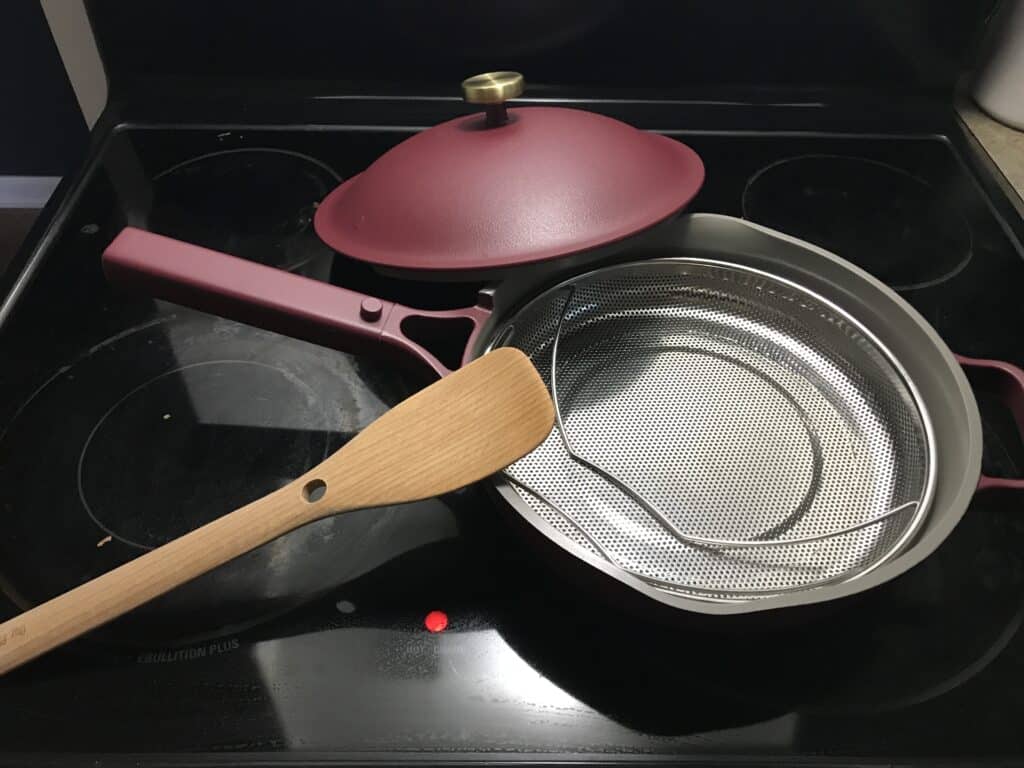
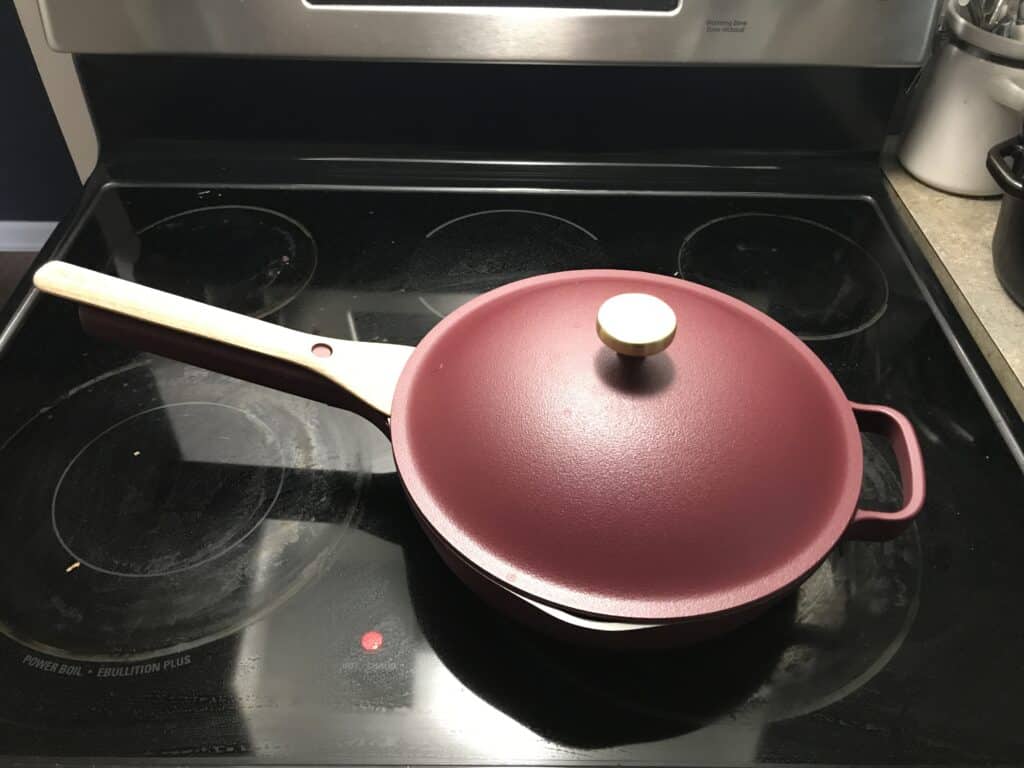
What we like
There’s no doubt that the Always Pan looks fabulous. This pan will improve your kitchen aesthetic and get some appreciative comments if you use it to serve meals at dinner parties.
That is, until it starts to stain, peel, and chip which seems to happen at the six month mark for many who at first loved the Always Pan.
And once the ceramic non-stick surface starts to chip and expose the aluminum below, you’re not going to want to use the pan anymore, lest aluminum leach into your food.
Aside from its appearance, other things we like about the Always Pan include its versatility. The 2.0 version is oven-safe where the original wasn’t. This is a big improvement, though you’ll still want to keep the oven temperature below 430 to be safe.
The Always Pan 2.0 in Standard size (the one I have) is a decent size for the stovetop too. It offers enough space to roast a cauliflower (hey, I’m vegan) and is still shallow enough that I can easily flip pancakes and, presumably, eggs.
The Always Pan 2.0 is meant to be able to:
- Braise
- Sear
- Steam
- Sauté
- Fry
- Boil
- Bake
- Strain
- Serve
- Store.
This list is where Our Place gets its claim for the Always Pan replacing 10 cookware items. Frankly, though, I use the same cast iron pan to do five of these things, a stainless steel pan to do at least two more, and I’m not sure how convenient it is to store food in this large pan with a long handle instead of just using dedicated glass containers.
Other features I like include:
- Two pour spouts (works for lefties, righties, and whatever your kitchen set-up)
- Subtle company logo to indicate lid position to trap or release steam
- Spacious steamer basket that doubles as a strainer – though it’s strange that this is metal, given the ceramic coating (why not include a bamboo steamer instead, Our Place?)
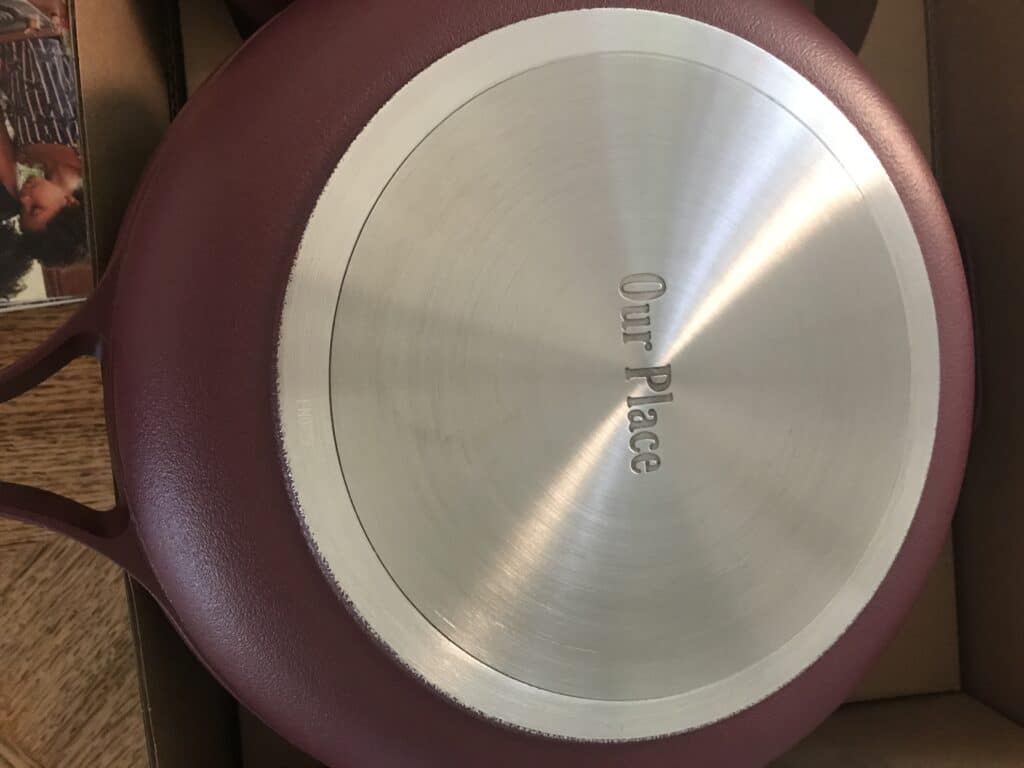
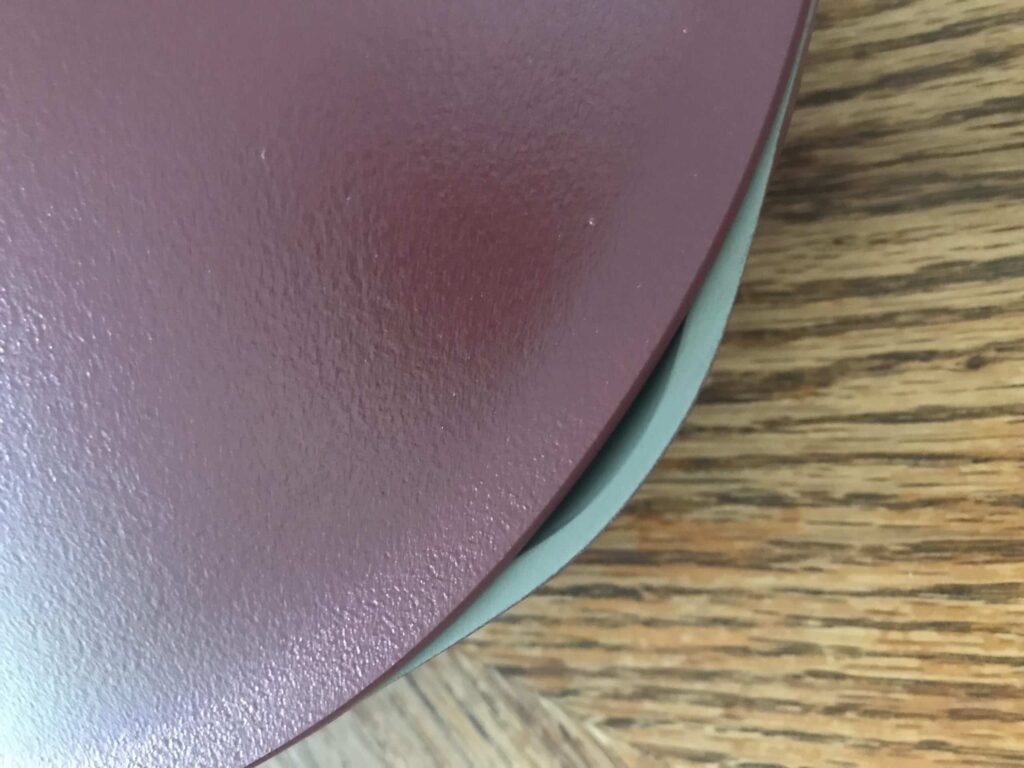
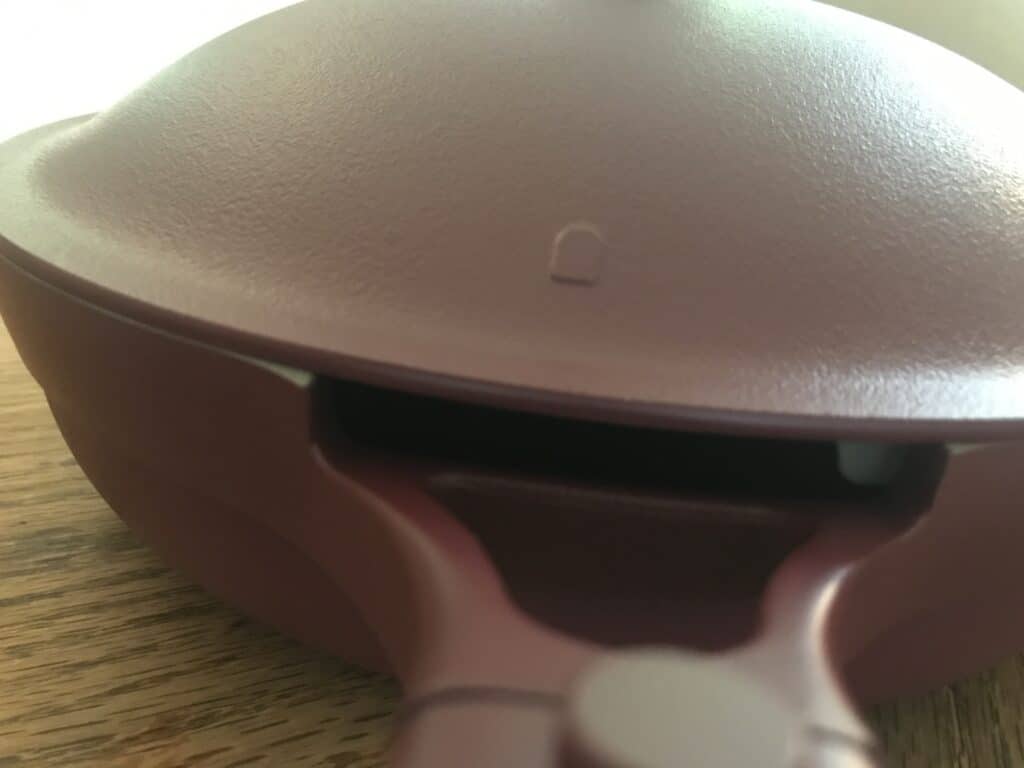
Cooking with the Always Pan 2.0
I love cooking things like soccatata in my cast iron, where the dish starts on the stove and then bakes in the oven. With my cast iron, the soccatata can sometimes stick to the pan if I’m not careful. With the Always Pan 2.0, this doesn’t happen.
I’ve also used the Always Pan 2.0 for steaming veggies. The steamer basket looks great but it sits so low in the pan that I could only pour a couple of cups of water in there before my carrots started swimming. Thus, the steamer basket becomes a boiler basket.
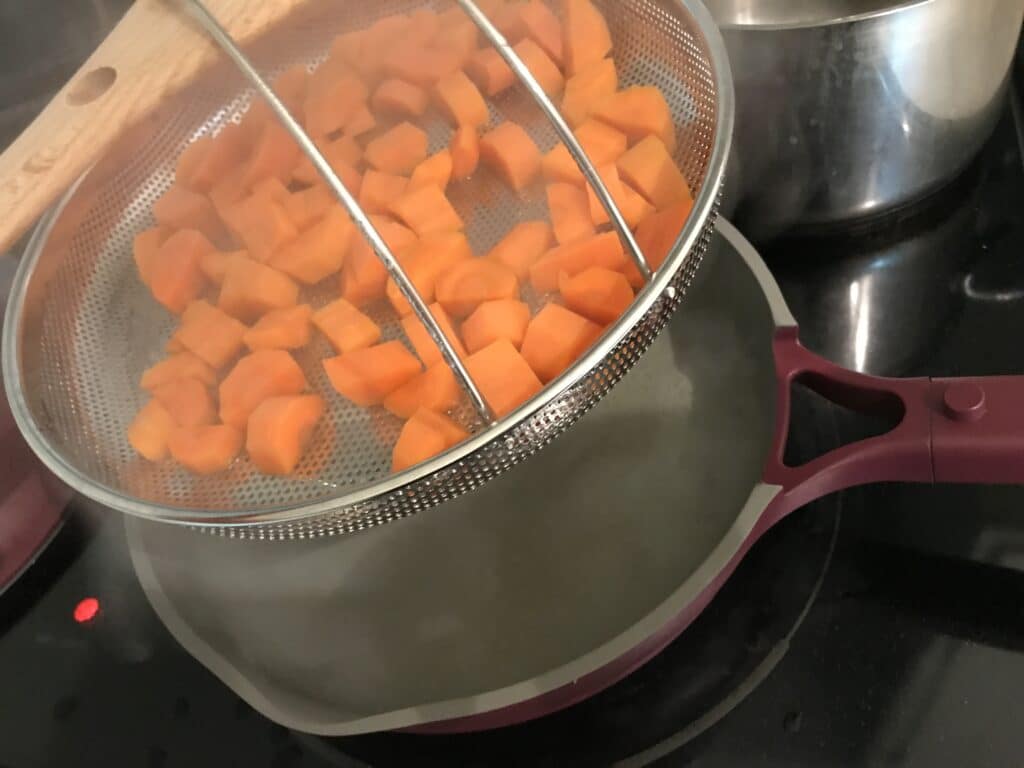
If I put in less water, there’s a risk of the pan boiling dry, which would damage it irreparably. I felt I had to constantly monitor the pan, instead of being able to multitask. Not ideal for this busy mama of a rambunctious toddler!
I also usually steam veggies over the top of something like pasta or potatoes, using my stainless steel cookware. This is much more efficient and far less anxiety inducing than using the Always Pan steamer.
The Always Pan is surprisingly good for cooking noodles, though if you’re making noodles, chances are you also want to use the pan to make a sauce or broth! This in itself undermines the ‘10 products in one’ idea. Unless, of course, you purchase the cookware set with two Always Pans of different sizes.
Is the Always Pan 2.0 non-stick?
Oof. This is the kicker.
At first, the Always Pan 2.0 is impressively non-stick. Even more so than the Alva non-stick ceramic coated pan I love.
My wife and I have been really impressed with the slipperiness of the Always Pan 2.0 cooking surface. We like to cook with oil, but you definitely don’t need much to keep this pan non-stick.
The trouble is that the pan has a reputation for losing that impressive slipperiness very quickly. And if you don’t baby your pan, things seem to go downhill very fast indeed. We have had the pan for five months and it’s in near constant use (my wife still loves it), with no loss of slipperiness so far. It’s also still super easy to clean.
I live in fear, though, of having to take this beautiful (and expensive) pan to the recycling depot.
To keep that non-stick surface in good shape, the Always Pan 2.0 requires careful use and maintenance.
Care and use
For someone like me, who loves cast iron cookware and the beating it can take, the fussiness of this pan is rather irritating.
In fact, when I let my wife know that she probably had the pan on too high a heat, she scowled at me and said that was ridiculous. I agree! The pan should be able to take a 6 or 7 out of 8 on our stovetop, but we keep it at a 4 or below, in fear of ruining the pan.
My wife also noted that she hadn’t seen the heat setting advice anywhere on the packaging (though it is on the initial care sticker), and that a cursory look at the product page wouldn’t suggest caution over using high heat. In fact, given it’s meant for use searing food, the marketing suggests the opposite.
Her view? Our Place deliberately hides the need for low-medium heat only because it’s embarrassed to have made a pan that can’t stand the heat.
How do I know it’s meant to be low-medium heat? Aside from the initial care sticker, if you click to expand the care and use tab on the Always Pan 2.0 product page, it says:
Use low-medium heat to preserve the nonstick coating — never heat an empty pan
Our Place website
For the best chance of keeping your Always Pan 2.0 in good working order (and looking good):
- Choose your cooking oils wisely – high smoke point only and no spray oils
- Use only low to medium heat – never high heat
- Avoid spillovers – just one can ruin the look of your pan forever
- Use silicone or wooden cooking utensils only – no metal, ever
- Clean the pan fully, removing all traces of oil and food after every use
- Don’t use the dishwasher!
- Only use a soft scrubber, with no abrasive cleaners
- Be careful to store your pan so it doesn’t get knocked or bumped.
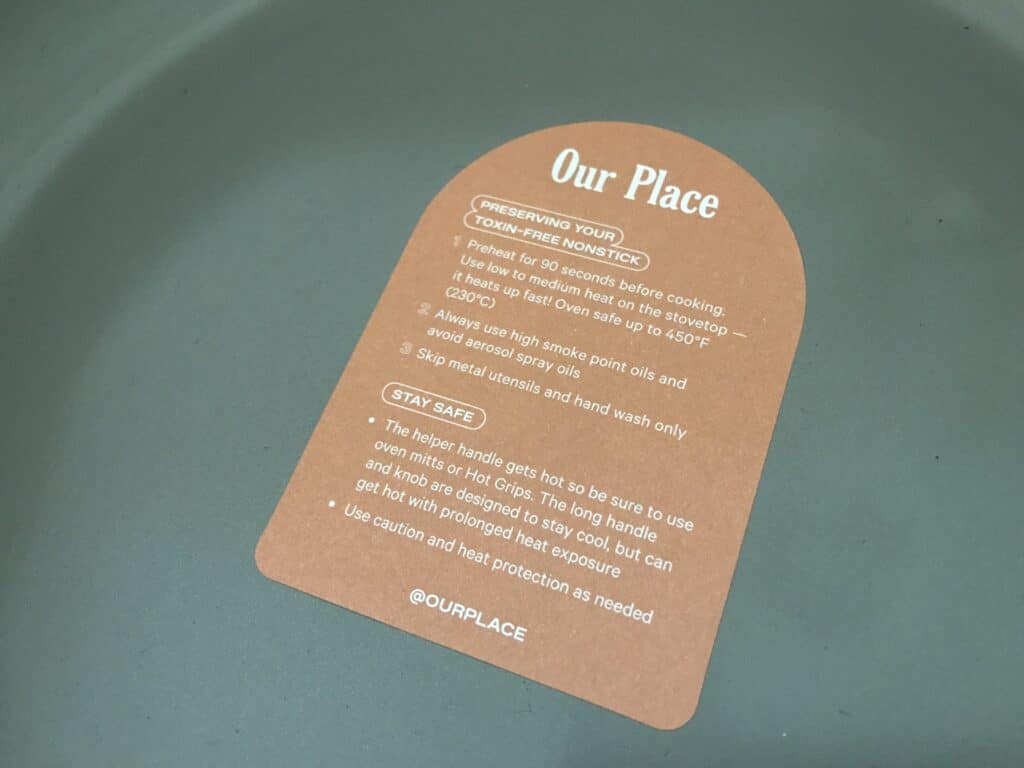
Downsides
I’ve already mentioned a few issues with the Always Pan 2.0, including:
- A steamer basket that sits too low in the pan to be useful for much besides boiling and draining
- Fussy care and maintenance
- Need to use low-medium heat only
- Poor transparency on leach testing etc.
- Made of aluminum, not 3-ply stainless steel
- Versatile, but hard to use for more than one thing at a time.
That last point is key because while this pan is meant to replace a bunch of other cookware and be great for apartments or small kitchens, you’re still going to need other pots and pans. And if you have a smaller space, this pan may be the always out pan simply because it’s bulk means it doesn’t fit easily in a cupboard and crowds out other cookware on a 24-inch stovetop.
For most people, however, the biggest downside of the Always Pan 2.0 is the price. If you consider that the pan may only last six months without becoming sticky and no fun to cook with, the $150 price tag works out to about $25 per month!
Compare that to a Lodge Cast Iron Skillet with Lid that will set you back about $70 total. This non-toxic cookware does many of the same things, and lasts a lifetime (at least).
On that basis, the Always Pan 2.0 doesn’t seem very sustainable or budget friendly at all.
And that’s not where the issues end.
Form over function
For a product so heavily marketed on instagram, it’s perhaps not surprising that the Always Pan 2.0 tends to favor form over function.
For instance, one of the features of the Always Pan 2.0 that feels more for show than anything else is the handle design with beechwood spatula.
Unless this pan truly is the only pan you own and this spatula the one you always use, you’re clearly going to need somewhere else to rest a wooden spoon or spatula when cooking. This immediately renders the handle design redundant and, frankly, irritating.
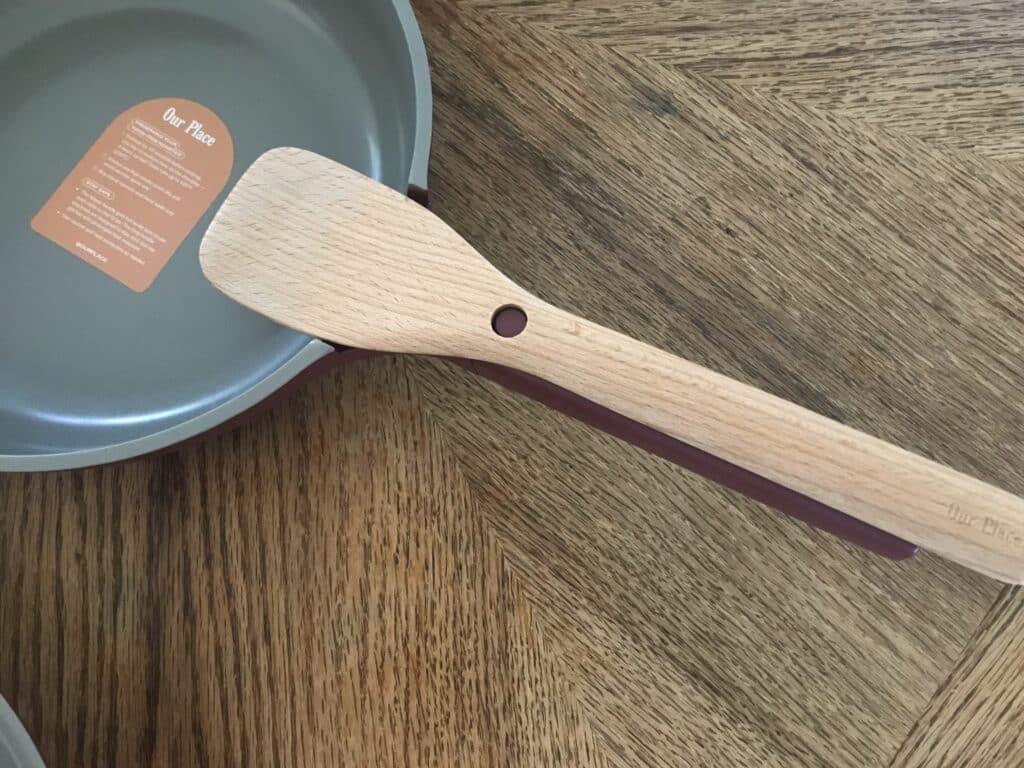
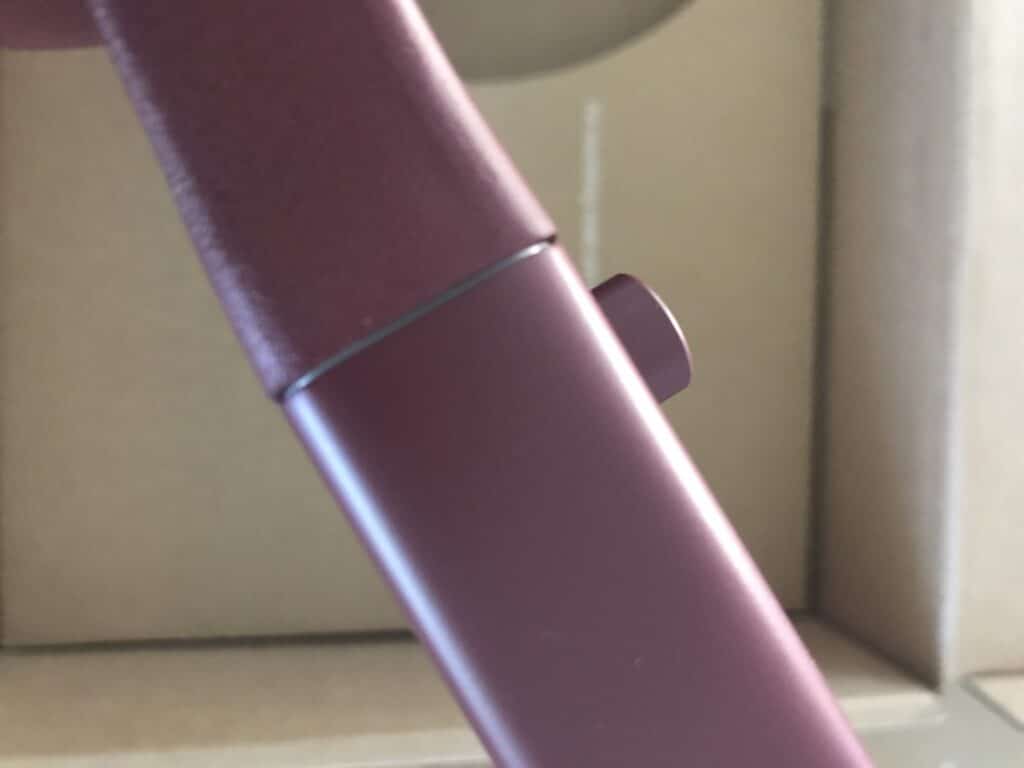
In addition, constant exposure to moisture and heat means this spatula will degrade much quicker than one you rest away from the stovetop like all your other kitchen utensils.
It makes no sense to require the handle to be boxy in order to accommodate a flat spatula. A rounded long handle is far more ergonomic. The straight sides of the Always Pan 2.0 handle actually make it quite uncomfortable to hold the pan for any length of time, especially if it’s got a good amount of food in it adding to the weight. And because that helper handle gets too hot to hold, this pan is very awkward to tip to pour out food.
Always Pan 2.0 vs. the original
At first glance, most of the bad reviews on the Our Place website for the Always Pan seemed to be for the original, with few dating beyond 2021. Look elsewhere, though, and there are plenty of folks who bought the 2.0 and are also unhappy.
Our Place did seemingly take on board some criticisms of the original Always Pan and changed a few things for the 2.0., which came out in April 2023.
More durable non-stick coating
One of the biggest changes was to the ceramic coating. Now, Our Place uses Thermakind™, a proprietary ceramic non-stick coating that is still based on silicon instead of PTFE. Our Place says that this coating is “made without potentially toxic materials like PFAS (including PTFEs and PFOAs), lead and cadmium.”
The coating is also meant to last 50% as long as the original coating. So, based on reviews of the original, that could buy you about 12 months instead of six months of use.
I didn’t have a chance to use the original Always Pan, but those who have compared the two do seem to be impressed at the greater thickness of the ceramic coating and improved resistance to scratches.
The other big difference between the original and the 2.0 Always Pan is that the latter is now oven-safe. That means you can go from stovetop to oven (230 C / 440 F) without fear of your pan blistering or cracking.
Compared to the original Always Pan, the 2.0 is also lighter and nimbler. It weighs just 3 lb. without the lid, versus 4 lb. for the original, though the pan remains the same size and shape.
Several things did not improve, however, between the original Always Pan and the 2.0.
Issues Our Place didn’t fix for the Always Pan 2.0
For some unknown reason, Our Place doesn’t use the same stay-cool stainless steel for the helper handle as it does for the long handle and the lid knob. Despite criticism of the original Always Pan, Our Place didn’t change this design for the 2.0.
The helper handle is made with the same aluminum as the body of the pan, meaning it heats up fast! This means you’ll definitely want to use an oven mitt or silicone protector before touching that helper handle as it gets extremely hot.
Given the too-hot-to-handle handle, you’d think Our Place would include a complementary set of its Hot Grips with every Always Pan 2.0.
The Always Pan 2.0 also still requires specific kinds of cooking oil to keep the non-stick surface in good condition (no cooking oil sprays). And it’s still best to use only low to medium heat and wash by hand once cooled.
Final thoughts
Overall, the Always Pan 2.0 looks beautiful, at least for a while. l also appreciate how the design is meant to replace several other kitchen staples to save space and cost, especially for apartment dwellers with little space for kitchen equipment.
In reality, though, this pan:
- Isn’t beginner-friendly
- Lose its non-stick properties fast
- Won’t last very long because it’s aluminum, not 3-ply or more stainless steel
- Is hard to store because of worries over scratches and chips
- Doesn’t actually replace 10 other kitchen items
- Has a very uncomfortable long handle and an unsafe helper handle
- Requires fussy care
- Is not certified non-toxic, with nothing to back up Our Place’s claims.
On the plus side, the 2.0 is better than the original Always Pan, with a longer lasting non-stick surface. It’s also oven safe, which is a nice touch missing from the original.
Perhaps acknowledging the sheer number of unhappy customers with the original Always Pan, Our Place now includes a quick care guide as a sticker on the pan itself (remove before first use!). This helps explain how best to preserve the non-stick coating and keep your pan looking good for longer.
Still, given that the Always Pan 2.0 is meant to be a great cookware choice for beginner cooks, it’s not very beginner friendly. Cast iron, carbon steel, and even stainless steel are more forgiving, budget-friendly, and durable.
All in all, if you don’t cook much, have very little kitchen space, are happy to closely follow the care and use instructions, and really love the look of the Always Pan 2.0, go for it. Chances are the ceramic coating is harmless, though we can’t know for sure until Our Place releases its test results.
If, however, you’re a more seasoned cook, have more space, tend to be clumsy with cookware, want something that will really stand the test of time or want to be sure your pan is non-toxic, go for cast iron or carbon steel. Sure, these aren’t as slippery and non-stick as the Always Pan 2.0 on first use, but they’ll certainly last far longer and be more fun to cook with as you gain experience.
See also: The best non-stick, non-toxic frying pans
FAQs
The Always Pan 2.0 is unquestionably unique. That said, now it’s been around for four years or so, other cookware companies are getting in on the game.
One notable alternative to the Always Pan 2.0 is the Ninja Foodi NeverStick PossiblePan. At first glance it looks pretty similar to the Always Pan, with a steamer basket, nesting spatula, versatility, and various color options. It’s also oven-friendly to 500 F, and dishwasher safe. However, this pan is non-stick thanks to PTFE, so it will release dangerous fumes and degrade fast if you heat the pan over 500 F. It’s also not durable or non-toxic, so is a no-go for us.
No.
If you have room to carefully store the Always Pan 2.0 in your kitchen, you absolutely have room to store much more robust cast iron, carbon steel, and stainless steel cookware. These, you can stack with abandon and bump and bang without having to worry about chipping the coating. They’ll last forever, are much more budget-friendly, and are also better for the environment overall.
If you really need a non-stick pan, my favorite alternative to the Always Pan 2.0 is the Maestro non-stick frying pan from Alva (see our review). This is third-party tested as non-toxic, genuinely non-stick, and a staple in our kitchen. Sure, it is just a frying pan, but it’s a lot less expensive than the Always Pan 2.0, will likely last longer, is made with recycled materials by a sustainable company, and is part of a high quality cookware collection.
